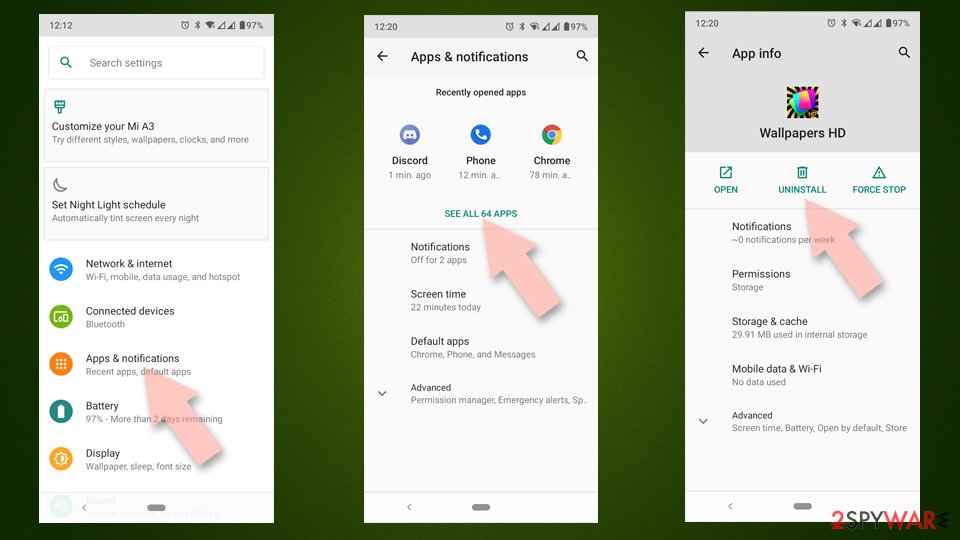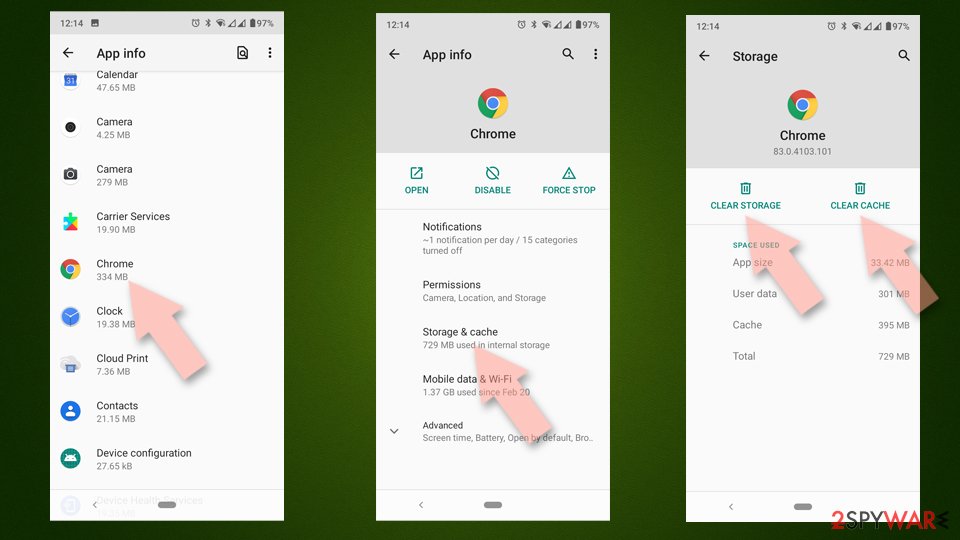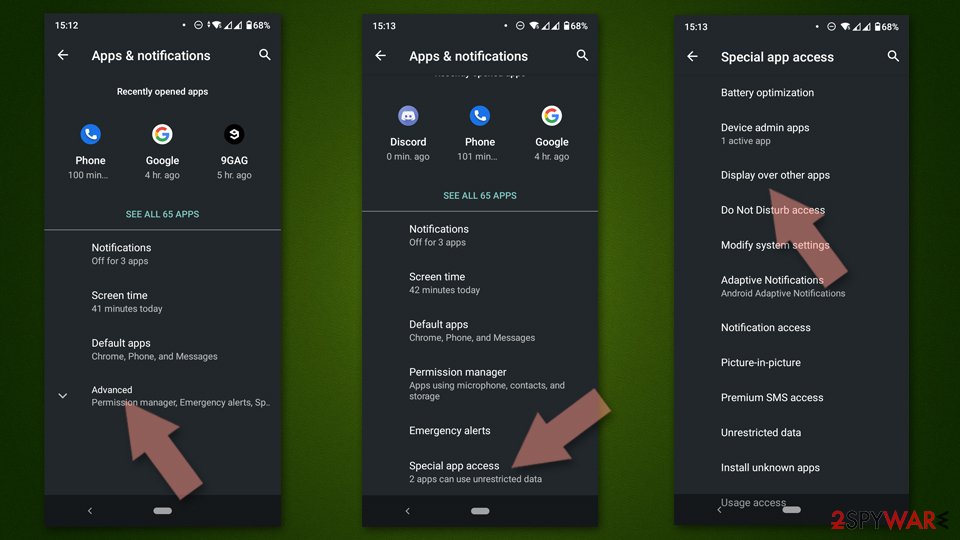Districtbaloneywhiskers.com (Easy Removal Guide) - Free Instructions
Districtbaloneywhiskers.com Removal Guide
What is Districtbaloneywhiskers.com?
Districtbaloneywhiskers.com – a site that tricks users to enable push notifications

Districtbaloneywhiskers.com is a website that urges users to subscribe to its notifications enabling it to display deceptive ads even when browsers aren't opened. The desktop notification comes straight to the corner of the screen. If users press the Allow button, their devices (Windows, Mac, Android, etc.) are immediately starting to show suspicious content. If that happens consistently your device can be infected with adware.[1]
These intrusive Districtbaloneywhiskers.com ads will start popping up at the right corner of computers or be sent as notifications to cell phone screens. Their contents might be inappropriate or reroute to commercial sites. Furthermore, the displayed ads might redirect to websites other than the advertised content and might lead to high-risk portals.
If users are redirected to Districtbaloneywhiskers.com site, that means they have adware or other potentially unwanted programs (PUPs) installed on their devices. This website isn't malicious, but its ads might be, so we glad you came to us to find out how to get rid of it. This article covers functions, delivery methods, and of course, provides removal instructions for this adware.
| name | Districtbaloneywhiskers.com |
|---|---|
| type | Redirect, adware |
| IP address | 192.243.59.13 |
| Symptoms | Pop-ups, banners, surveys, and other kinds of ads covering the entire page, popping up directly on the screen. Redirects to high-risk sites. Slower device performance |
| Risks | Installation of PUPs or even malware, privacy issues |
| Distribution | Deceptive ads, fake software updaters, freeware bundles |
| Elimination | Automatic removal with anti-malware software is suggested. Manual removal options are displayed at the bottom of the article |
| System fix | Clean and optimize your device with powerful system repair tools such as the FortectIntego app |
Districtbaloneywhiskers.com push notification virus might jeopardize the device's privacy and security as its ads might lead to hazardous sites that have nothing to do with the advertised content. Redirects might happen to adult sites, online gambling, or gaming portals. Also, to websites that would push users into downloading and installing fake updates, which would result in additional PUP infections or, even worse – malware infections.[2]
Since people don't visit portals like Districtbaloneywhiskers.com of their own volition, PUP operators redirect to these types of sites using adware, browser hijackers, and junkware alike. So if you're redirected to this site, you have some sort of computer infection.
Once the Districtbaloneywhiskers.com notifications are enabled, the device in use is immediately infected with adware that will result in an abundance of ads. If any of the displayed ads get clicked, either intentionally or accidentally, more PUPs are more likely to be installed.
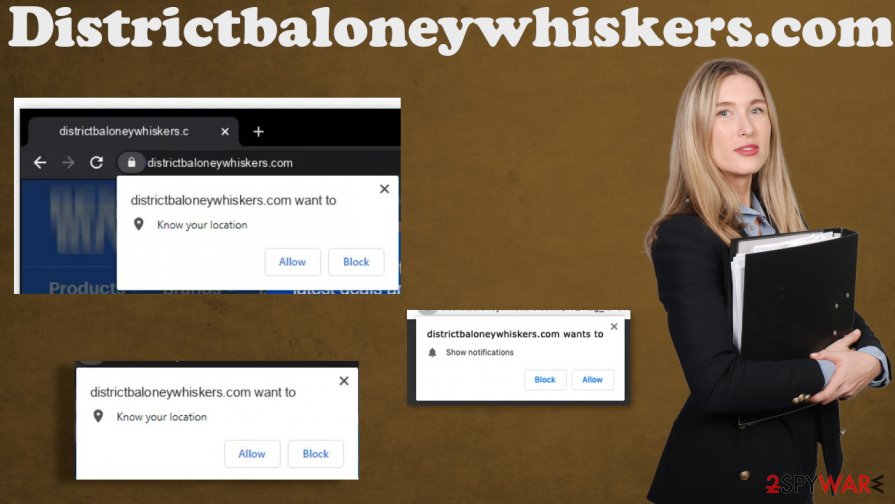
We recommend scanning devices with professional anti-malware tools like SpyHunter 5Combo Cleaner or Malwarebytes to determine whether adware or malware is installed on devices and remove Districtbaloneywhiskers.com virus along with any other suspicious files that the software detects. A proper system scan can show if the PUP managed to find the way on the machine with other applications at the same time.
To restore your system files and settings and get the best available performance from your machine, experts[3] recommend using the FortectIntego or a different optimization, system repair tool. Users are advised to do that only after a successful Districtbaloneywhiskers.com removal. If ads are still popping up, refer to our manual removal guides below.
Identify push notification websites to evade adware and other PUP infections
Operators of websites where users could be infected with push notification viruses use various sneaky techniques to try and fool them. The main goal is to trick users into pressing the Allow button, which automatically subscribes to these portals' alerts. This results in excessive ad placement, generating revenue for the operators.
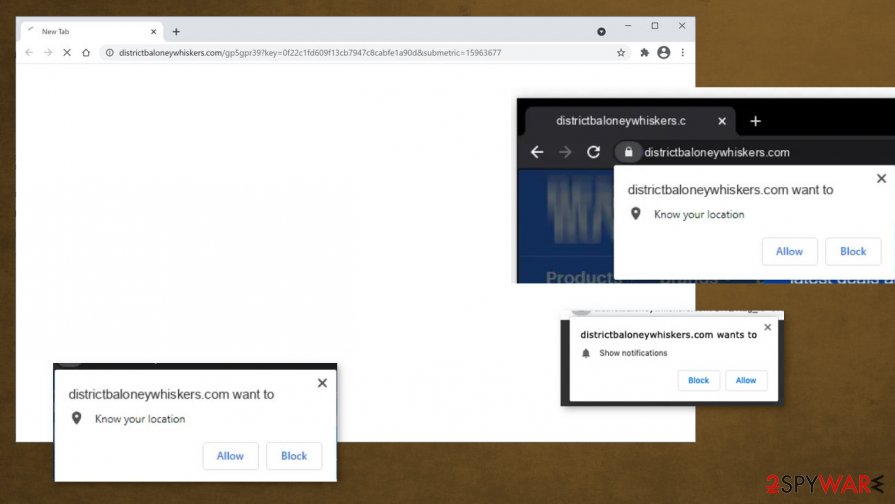
One of the tricks that push notification websites to use is by claiming that a visitor must allow notifications to see some hidden content, imaginary breaking news, secret video, and alike. No legitimate site would ever push its visitors to view some content.
Legit portals can sometimes ask users to prove that they're not robots by completing a captcha or something similar. Shady websites decided to exploit that by stating that users must press the Allow button to prove that they're human. If you ever encounter a website that forces you to subscribe to its alerts in any way – close the tab and never revisit the site again.
Districtbaloneywhiskers.com virus removal tutorial for affected devices
When either Districtbaloneywhiskers.com redirect or pop-up advertisements are happening on a device, that could mean only one thing – your device is infected with a potentially unwanted program. Junkware isn't as hazardous as malware, but nonetheless, it should be eliminated swiftly.
Districtbaloneywhiskers.com removal should be done in two ways. First of all, scan your device with reliable anti-malware software like SpyHunter 5Combo Cleaner or Malwarebytes to remove any PUPs responsible. Then eliminate it from your affected Safari, Chrome, or other browsers. If you're not sure how to do that, please refer to our free instructions below.
After you successfully remove Districtbaloneywhiskers.com from your device and your browser, you should use powerful system repair tools. Try FortectIntego. That way, you'll make sure that the system irregularities are fixed, and the performance will be stable. If you have any further questions, please feel free to leave them at our Ask Us interface.
Getting rid of Districtbaloneywhiskers.com. Follow these steps
Uninstall from Android
Uninstall unwanted programs from Android device:
- Go to Settings -> Apps/Applications.
- Expand the full list of the installed apps.
- Scroll through the list and tap on a suspicious application once.
- Tap on it and select Uninstall.

- Reboot the device.
Clear Storage and data files on Android from Google Chrome or other apps:
- Go to Settings > Apps/Applications.
- Expand the full list of the installed apps.
- Tap on Chrome and select Storage & cache.
- Clear storage and clear cache of the app.

If you are seeing ads on top of other apps but are not sure what is causing it, perform the following steps:
- Go to Apps/Applications.
- Tap Advanced.
- Select Special App access.
- Tap on Display over other apps.

- Eliminate apps with these access rights enabled.
Stop browser notifications
Remove unwanted notifications from Google Chrome (desktop):
- Open Google Chrome browser and go to Menu > Settings.
- Scroll down and click on Advanced.
- Locate Privacy and security section and pick Site Settings > Notifications.

- Look at the Allow section and look for a suspicious URL.
- Click the three vertical dots next to it and pick Block. This should remove unwanted notifications from Google Chrome.

Remove unwanted notifications from Google Chrome (Android):
- Open Google Chrome and tap on Settings (three vertical dots).
- Select Notifications.
- Scroll down to the Sites section.
- Locate the unwanted URL and toggle the button to the left (Off setting).

Remove unwanted notifications from Mozilla Firefox:
- Open Mozilla Firefox and go to Menu > Options.
- Click on Privacy & Security section.
- Under Permissions, you should be able to see Notifications. Click the Settings button next to it.

- In the Settings – Notification Permissions window, click on the drop-down menu by the URL in question.
- Select Block and then click on Save Changes. This should remove unwanted notifications from Mozilla Firefox.

Remove unwanted notifications from Safari:
- Click on Safari > Preferences…
- Go to the Websites tab and, under General, select Notifications.
- Select the web address in question, click the drop-down menu and select Deny.

Remove unwanted notifications from MS Edge:
- Open Microsoft Edge, and click the Settings and more button (three horizontal dots) at the top-right of the window.
- Select Settings and then go to Advanced.
- Under Website permissions, pick Manage permissions and select the URL in question.

- Toggle the switch to the left to turn notifications off on Microsoft Edge.

Remove unwanted notifications from MS Edge (Chromium):
- Open Microsoft Edge, and go to Settings.
- Select Site permissions.
- Go to Notifications on the right.
- Under Allow, you will find the unwanted entry.
- Click on More actions and select Block.

Remove unwanted notifications from Internet Explorer:
- Open Internet Explorer, and click on the Gear icon at the top-right of the window.
- Select Internet options and go to the Privacy tab.
- In the Pop-up Blocker section, click on Settings.
- Locate web address in question under Allowed sites and pick Remove.

Uninstall from Windows
Instructions for Windows 10/8 machines:
- Enter Control Panel into Windows search box and hit Enter or click on the search result.
- Under Programs, select Uninstall a program.

- From the list, find the entry of the suspicious program.
- Right-click on the application and select Uninstall.
- If User Account Control shows up, click Yes.
- Wait till uninstallation process is complete and click OK.

If you are Windows 7/XP user, proceed with the following instructions:
- Click on Windows Start > Control Panel located on the right pane (if you are Windows XP user, click on Add/Remove Programs).
- In Control Panel, select Programs > Uninstall a program.

- Pick the unwanted application by clicking on it once.
- At the top, click Uninstall/Change.
- In the confirmation prompt, pick Yes.
- Click OK once the removal process is finished.
Delete from macOS
Remove items from Applications folder:
- From the menu bar, select Go > Applications.
- In the Applications folder, look for all related entries.
- Click on the app and drag it to Trash (or right-click and pick Move to Trash)

To fully remove an unwanted app, you need to access Application Support, LaunchAgents, and LaunchDaemons folders and delete relevant files:
- Select Go > Go to Folder.
- Enter /Library/Application Support and click Go or press Enter.
- In the Application Support folder, look for any dubious entries and then delete them.
- Now enter /Library/LaunchAgents and /Library/LaunchDaemons folders the same way and terminate all the related .plist files.

Remove from Microsoft Edge
Delete unwanted extensions from MS Edge:
- Select Menu (three horizontal dots at the top-right of the browser window) and pick Extensions.
- From the list, pick the extension and click on the Gear icon.
- Click on Uninstall at the bottom.

Clear cookies and other browser data:
- Click on the Menu (three horizontal dots at the top-right of the browser window) and select Privacy & security.
- Under Clear browsing data, pick Choose what to clear.
- Select everything (apart from passwords, although you might want to include Media licenses as well, if applicable) and click on Clear.

Restore new tab and homepage settings:
- Click the menu icon and choose Settings.
- Then find On startup section.
- Click Disable if you found any suspicious domain.
Reset MS Edge if the above steps did not work:
- Press on Ctrl + Shift + Esc to open Task Manager.
- Click on More details arrow at the bottom of the window.
- Select Details tab.
- Now scroll down and locate every entry with Microsoft Edge name in it. Right-click on each of them and select End Task to stop MS Edge from running.

If this solution failed to help you, you need to use an advanced Edge reset method. Note that you need to backup your data before proceeding.
- Find the following folder on your computer: C:\\Users\\%username%\\AppData\\Local\\Packages\\Microsoft.MicrosoftEdge_8wekyb3d8bbwe.
- Press Ctrl + A on your keyboard to select all folders.
- Right-click on them and pick Delete

- Now right-click on the Start button and pick Windows PowerShell (Admin).
- When the new window opens, copy and paste the following command, and then press Enter:
Get-AppXPackage -AllUsers -Name Microsoft.MicrosoftEdge | Foreach {Add-AppxPackage -DisableDevelopmentMode -Register “$($_.InstallLocation)\\AppXManifest.xml” -Verbose

Instructions for Chromium-based Edge
Delete extensions from MS Edge (Chromium):
- Open Edge and click select Settings > Extensions.
- Delete unwanted extensions by clicking Remove.

Clear cache and site data:
- Click on Menu and go to Settings.
- Select Privacy, search and services.
- Under Clear browsing data, pick Choose what to clear.
- Under Time range, pick All time.
- Select Clear now.

Reset Chromium-based MS Edge:
- Click on Menu and select Settings.
- On the left side, pick Reset settings.
- Select Restore settings to their default values.
- Confirm with Reset.

Remove from Mozilla Firefox (FF)
Remove dangerous extensions:
- Open Mozilla Firefox browser and click on the Menu (three horizontal lines at the top-right of the window).
- Select Add-ons.
- In here, select unwanted plugin and click Remove.

Reset the homepage:
- Click three horizontal lines at the top right corner to open the menu.
- Choose Options.
- Under Home options, enter your preferred site that will open every time you newly open the Mozilla Firefox.
Clear cookies and site data:
- Click Menu and pick Settings.
- Go to Privacy & Security section.
- Scroll down to locate Cookies and Site Data.
- Click on Clear Data…
- Select Cookies and Site Data, as well as Cached Web Content and press Clear.

Reset Mozilla Firefox
If clearing the browser as explained above did not help, reset Mozilla Firefox:
- Open Mozilla Firefox browser and click the Menu.
- Go to Help and then choose Troubleshooting Information.

- Under Give Firefox a tune up section, click on Refresh Firefox…
- Once the pop-up shows up, confirm the action by pressing on Refresh Firefox.

Remove from Google Chrome
Delete malicious extensions from Google Chrome:
- Open Google Chrome, click on the Menu (three vertical dots at the top-right corner) and select More tools > Extensions.
- In the newly opened window, you will see all the installed extensions. Uninstall all the suspicious plugins that might be related to the unwanted program by clicking Remove.

Clear cache and web data from Chrome:
- Click on Menu and pick Settings.
- Under Privacy and security, select Clear browsing data.
- Select Browsing history, Cookies and other site data, as well as Cached images and files.
- Click Clear data.

Change your homepage:
- Click menu and choose Settings.
- Look for a suspicious site in the On startup section.
- Click on Open a specific or set of pages and click on three dots to find the Remove option.
Reset Google Chrome:
If the previous methods did not help you, reset Google Chrome to eliminate all the unwanted components:
- Click on Menu and select Settings.
- In the Settings, scroll down and click Advanced.
- Scroll down and locate Reset and clean up section.
- Now click Restore settings to their original defaults.
- Confirm with Reset settings.

Delete from Safari
Remove unwanted extensions from Safari:
- Click Safari > Preferences…
- In the new window, pick Extensions.
- Select the unwanted extension and select Uninstall.

Clear cookies and other website data from Safari:
- Click Safari > Clear History…
- From the drop-down menu under Clear, pick all history.
- Confirm with Clear History.

Reset Safari if the above-mentioned steps did not help you:
- Click Safari > Preferences…
- Go to Advanced tab.
- Tick the Show Develop menu in menu bar.
- From the menu bar, click Develop, and then select Empty Caches.

How to prevent from getting adware
Protect your privacy – employ a VPN
There are several ways how to make your online time more private – you can access an incognito tab. However, there is no secret that even in this mode, you are tracked for advertising purposes. There is a way to add an extra layer of protection and create a completely anonymous web browsing practice with the help of Private Internet Access VPN. This software reroutes traffic through different servers, thus leaving your IP address and geolocation in disguise. Besides, it is based on a strict no-log policy, meaning that no data will be recorded, leaked, and available for both first and third parties. The combination of a secure web browser and Private Internet Access VPN will let you browse the Internet without a feeling of being spied or targeted by criminals.
No backups? No problem. Use a data recovery tool
If you wonder how data loss can occur, you should not look any further for answers – human errors, malware attacks, hardware failures, power cuts, natural disasters, or even simple negligence. In some cases, lost files are extremely important, and many straight out panic when such an unfortunate course of events happen. Due to this, you should always ensure that you prepare proper data backups on a regular basis.
If you were caught by surprise and did not have any backups to restore your files from, not everything is lost. Data Recovery Pro is one of the leading file recovery solutions you can find on the market – it is likely to restore even lost emails or data located on an external device.
